Abstract
Background:
The phytochemical analysis of Stachys alopecuros subsp. divulsa, an endemic Italian species, has been recently reported and has showed the presence of 8-O-acetylharpagide (2), harpagide (3), allobetonicoside (4), and 4¢-O-galactopyranosyl-teuhircoside (5). In this paper, an in deep study of its glycosidic fraction with the aim to widen the knowledge on its secondary metabolites content is reported.
Materials and Methods:
Chromatographic techniques were used for the isolation of constituents while spectroscopic and spectrometric techniques were applied for the structures elucidation.
Results:
Besides the known constituents, all of them reconfirmed, ajugoside (1), reptoside (6) and 6-O-acetyl-ajugol (7) were also identified among the iridoids while the phenolic components resulted to be chlorogenic acid (8), b-arbutin (9), verbascoside (10), and stachysoside A (11), instead.
Conclusion:
The iridoid pattern of S. alopecuros subsp. divulsa has been expanded with the identification of not previously reported compounds as well as for the phenolic fraction. Except for the reconfirmed verbascoside (10), the other phenolic compounds were recognized for the first time in the studied species. The complete NMR assignment of compound (1) by means of bidimensional techniques is reported, and both the chemotaxonomic and pharmacological relevance of the isolated compounds is largely discussed.
KEY WORDS: Chemotaxonomy, chlorogenic acid, iridoid, NMR, phenylethanoid glycosides, β-arbutin
INTRODUCTION
The genus Stachys comprises more than 450 species mainly distributed in warm-temperate regions of the Mediterranean basin and South-Western Asia. It represents one of the largest genera of Lamiaceae family [1], and the majority of the species belonging to this genus have been largely used in the traditional medicine. Stachys spp. are currently indicated as “Mountain tea” in several regions reflecting their principal use in infusions and decoctions. The genus Stachys is represented by annual or perennial herbs known for their interesting biological activities, i.e., anti-inflammatory [2], antispasmodic, sedative, and diuretic [3-5]. Several phytochemical components, which may be responsible of the biological activities, have been isolated from Stachys species, i.e., iridoids [6,7], phenylethanoid glycosides, flavonoids [8,9], acidic metabolites, polysaccharides, and terpenoids [10].
In Italy, the genus Stachys encompasses about 30 species and subspecies among which five species are considered endemic. Stachys alopecuros subsp. divulsa is one of these. This plant is characteristic of the mountain habitat of central Italy, being distributed only in a few regions (Umbria, Marche, Abruzzo, Lazio, and Molise) [11], on stony mountain pastures, scrubs, and screes, and preferring a calcareous, and dry soil up to 2000 m a.s.l. S. alopecuros subsp. divulsa is a perennial plant with small, hirsute, and subcylindrical ascending stem. The opposite leaves are petiolate and densely hairy on the edge and along the veins. The flowers are gathered in small verticillasters held in a dense spike, yellow-white in color and blooming from June to August-September. The fruits, which are brown colored, are constituted by 4 ovate nuculae [12]. A previous study on this subspecies revealed the presence of phenypropanoid, saponin, and iridoid glycosides [6] which are considered taxonomic markers for the genus and the family. In this paper, we reported a reassessment of the polar fraction constituents of this plant employing a patented method allowing the isolation of secondary metabolites of glycosidic nature.
MATERIALS AND METHODS
Plant Materials
The fresh plant materials (aerial parts) were collected at the flowering stage from a spontaneous population growing at the altitude of 1520 m a.s.l. in the territory of Pizzo Tre Vescovi, Marche, Italy (GPS coordinates: N 42°58¢072, and E 13°14¢102). The botanical recognition was performed by one of us (F.M.) using available literature [12], and a representative specimen has been deposited in the Herbarium Universitatis Camerinensis (CAME, included in the online edition of Index Herbariorum c/o School of Biosciences and Veterinary Medicine, University of Camerino, Italy) under the codex CAME 24825. A sample of the studied species is also stored in our laboratory (code number SAD-30062012) for any further reference.
Instruments
NMR spectra were recorded on a Varian (now Agilent Technologies) Mercury 300 MHz instrument and/or on a Bruker Avance III 400 MHz instrument using D2O or CD3OD as deuterated solvents: The chemical shifts were expressed in ppm using the HDO signal to set the 1H-spectra acquired in D2O, while the internal solvent signal (m5) at 3.31 ppm was set as reference for the spectra in CD3OD.
MS spectra were performed on a Q-TOF MICRO spectrometer (Micromass, now Waters, Manchester, UK) equipped with an ESI source that operated in the negative and/or positive ion mode. The flow rate of sample infusion was 10 μL/min with 100 acquisitions per spectrum. Data were analyzed using the MassLynx software developed by Waters.
Solvents having RPE purity grade were all purchased from Sigma-Aldrich or Carlo Erba Reagenti, silica gel 60 (70-230 mesh ASTM) was purchased from Fluka.
Bidimensional NMR Experiments
Bidimensional spectra were performed on a Bruker Avance III 400 MHz instrument, operating at 9.4 T at 298 °K. Heteronuclear single quantum correlation (HSQC) experiments were acquired with a spectral width of 15 and 250 ppm for the proton and carbon, respectively, an average 1JC-H of 145 Hz, a recycle delay of 2 s and a data matrix of 4 K × 256 points. Heteronuclear multiple bond correlation (HMBC) experiments were acquired with a spectral width of 15 and 250 ppm for the proton and carbon, respectively, a long-range coupling constant of nJC-H of 8 Hz, a recycle delay of 2 s and a data matrix of 4 K × 256 points.
Extraction and Isolation of Polar Compounds
A portion of 390.0 g of hair-dried plant materials was extracted with a mixture of ethanol 96% and distilled water in ratio 8:2 v/v (1.4 L). The whole was left in maceration for 5 days so that the metabolites could come into solution. The procedure was repeated three times to achieve an exhaustive extraction. The solutions, having a dark green coloration, were gathered together in a same flask and then filtered. After filtration, the organic solvent was eliminated under reduced pressure at a temperature below 45°C until a water suspension was obtained. Throughout this last part, pH was checked on normal litmus paper, and this was about 8. This step is necessary to verify that pH is not too acid, meaning not under the value of 5.5, because an extreme acidity at this step may cause secondary reactions with the formation of several artifacts coming from the hydrolysis of glycosides and esters present in the extract. The water suspension was then frozen to −20°C and later lyophilized at the same temperature to preserve temperature-sensitive compounds possibly present. The final dried crude extract obtained from this methodology weighed 86.7 g and was dark green colored.
Adsorption Chromatography
The crude extract (86.7 g) was subjected to an active charcoal treatment. It was adsorbed on a stationary phase consisting in a mixture of charcoal/celite/polyamide (10:1:1) (60.0 g) until no reaction to vanillin/HCl spray reagent occured according to a method reported in the patent by Ballero et al. [13]. The resulting suspension was then stratified on a Gooch funnel and eluted first with H2O to eliminate the mono- and disaccharides. These usually coelute with glycosidic constituents in silica gel chromatography and may interfere during the structure identification of the metabolites of interest. The desorption chromatography was conducted in steps using EtOH/H2O mixtures gradually increasing in EtOH percentages (30, 60, and 95%). In this manner, three fractions at different polarity were collected, and after freeze drying 23.9, 4.70, and 0.82 g of solids were recovered, from the 30, 60 and 96% ethanolic elutions, respectively.
Silica Gel Column Chromatography
After a preliminary screening on thin layer chromatographys and paper chromatography, the separation step on silica gel column was first conducted on the 60% eluate because this showed the whole iridoid components and in comparable amount among them in respect to the other fractions. The 30% fraction, containing the more polar compounds, was partitioned in a second step. The 95% fraction did not contain iridoid glucosides and was not even considered.
The first chromatographic separation was performed on an aliquot of the 60% ethanolic elution for the weight of 4.0 g using 120.0 g of silica gel (ratio 1:30). The eluting system was a mixture of n-BuOH/H2O (82:18 v/v). From this chromatographic separation (Scheme 1) 11 compounds were isolated and identified by comparison with data reported in literature and/or by comparison with pure compounds available in our laboratory: Verbascoside (10, 12.4 mg) [14] from the assembly of fractions 8-15; stachysoside A (11, 11.2 mg) [8,15] in mixture with verbascoside (1:2) in the assembly of fractions 17-24; b-arbutin (9, 3.2 mg) [16] from the assembly of fractions 30-32; reptoside (6) [17] and 6-O-acetyl-ajugol (7) [18] in mixture in ratio 1:1.5 (25.0 mg) from the assembly of fractions 43-45; ajugoside (1, 113.7 mg) [17,19] as pure compound from the assembly of fractions 53-54; 8-O-acetyl-harpagide (2, 1.0 g) [20] from the assembly of fractions 70-88; chlorogenic acid (8) [21] in mixture with 8-O-acetyl-harpagide (2) in ratio 1:2 (109.4 mg) from the assembly of fractions 95-112; harpagide (3) [22] and chlorogenic acid (8) in mixture 3:1 (48.3 mg) from the assembly of fractions 118-122; allobetonicoside (4) and chlorogenic acid (8) in mixture 10:1 (29.1 mg) from the assembly of fractions 133-135; allobetonicoside (4, 100.7 mg) [23] as a pure compound from the assembly of fractions 144-163; 4¢-O-galactopyranosyl-teuhircoside (5) [6] in mixture with allobetonicoside (4) in ratio 3:1 (24.7 mg) from the assembly of fractions 166-169.
Scheme 1.
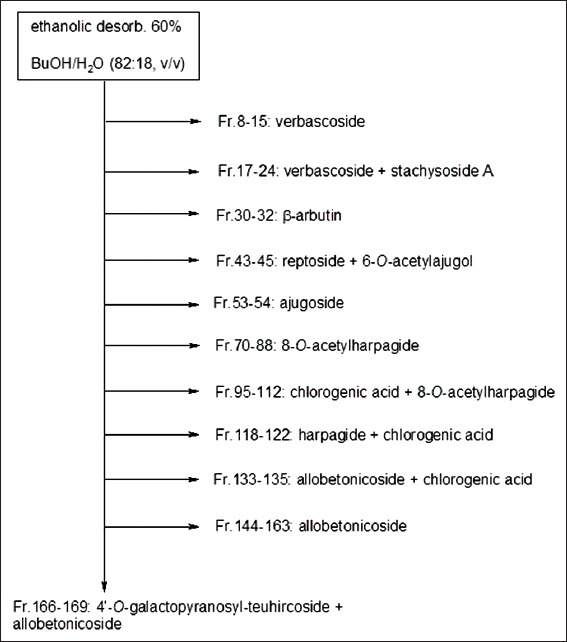
Chromatographic steps on 60% ethonolic fraction and elution order of components
A second chromatographic column was, instead, conducted on an aliquot of the 30% desorption solids (3.5 g). Similar compounds were isolated from this chromatographic step. In particular, harpagide (3), 8-O-acetylharpagide (2) as pure compounds, allobetonicoside (4) in mixture with 4¢-O-galactopyranosyl-teuhircoside (5), and ajugoside (1) occurring in traces (relative quantities not estimated). On the other hand, phenolic compounds as well as reptoside (6) and 6-O-acetyl-ajugol (7), were not found.
Spectral Data of the Isolated Compounds
Ajugoside (1): NMR data see Table 1; ESI-MS: m/z 412.80 [M+Na]+.
Table 1.
Complete NMR assignment of ajugoside (1) in D2O
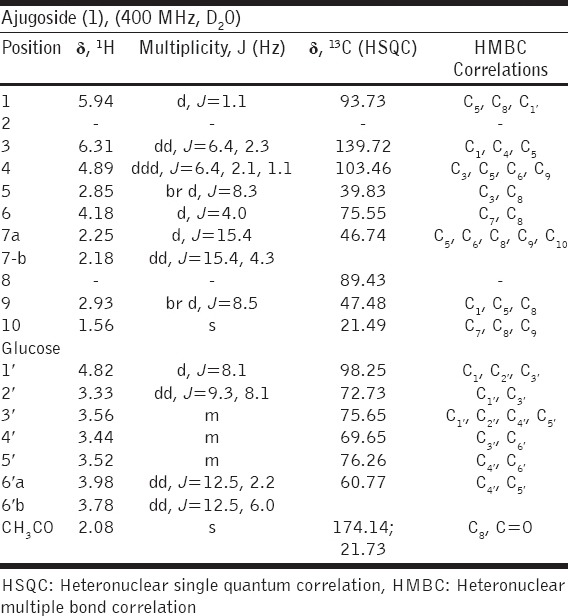
8-O-acetylharpagide (2): 1H NMR (300 MHz, CD3OD) d: 6.40 (1H, d, J = 6.4 Hz, H-3), 6.08 (1H, br s, H-1), 4.92 (1H, d, J = 6.5 Hz, H-4), 4.60 (1H, d, J = 7.8 Hz, H-1¢), 3.90 (1H, d, J = 11.8 Hz, H-6¢a), 3.71 (2H, m, H-6¢b; H-3¢), 3.44-3.29 (2H, m, H-4¢; H-5¢), 3.22 (1H, t like, J = 8.4 Hz, H-2¢), 2.86 (1H, br s, H-9), 2.18 (1H, d, J = 15.1 Hz, H-7a), 2.02 (3H, s, CH3CO), 1.94 (1H, dd, J = 15.2, 4.4 Hz, H-7b), and 1.45 (3H, s, H-10).
13C NMR (APT) (75 MHz, CD3OD) d: 173.3 (CH3CO), 143.8 (C-3), 106.8 (C-4), 99.8 (C-1¢), 94.5 (C-1), 88.6 (C-8), 78.0 (C-3¢), 77.6 (C-5¢), 77.4 (C-6), 74.4 (C-2¢), 73.3 (C-5), 71.6 (C-4¢), 62.8 (C-6¢), 55.4 (C-9), 46.0 (C-7), 22.5 (CH3CO), and 22.2 (C-10).
ESI-MS: m/z 429.04 [M+Na]+; m/z 835.19 [2M+Na]+.
Harpagide (3): 1H NMR (300 MHz, CD3OD) d: 6.32 (1H, d, J = 6.3 Hz, H-3), 5.74 (1H, br s, H-1), 4.95 (1H, d, J = 6.3 Hz, H-4), 4.58 (1H, d, J = 7.9 Hz, H-1¢), 3.90 (1H, d, J = 12.2 Hz, H-6¢a), 3.75-3.60 (2H, m, H-6¢b; H-3¢), 3.44-3.33 (2H, m, H-4¢; H-5¢), 3.26-3.16 (1H, dd, J = 8.8, 8.2 Hz, H-2¢), 2.56 (1H, br s, H-9), 1.90 (1H, dd, J = 13.8, 4.6 Hz, H-7a), 1.80 (1H, dd, J = 13.8, 3.6 Hz, H-7b), 1.25 (3H, s, H-10).
ESI-MS: m/z 387.14 [M+Na]+.
Allobetonicoside (4): 1H NMR (300 MHz, D2O) d: 6.43 (1H, d, J = 6.3 Hz, H-3), 6.11 (1H, br s, H-7), 5.94 (1H br s, H-1), 5.28 (1H, d, J = 8.3 Hz, H-1¢¢), 5.01 (1H, d, J = 6.3 Hz, H-4), 4.75 (1H, d, J = 7.8 Hz, H-1¢), 4.19 (1H, t, J = 2.6 Hz, H-9), 3.93 (2H, m, H-6¢a; H-6¢¢a), 3.83 (2H, m, H-6¢b; H-6¢¢b), 3.70-3.33 (8H, m, H-3¢; H-3¢¢; H-4¢; H-4¢¢; H5¢; H-5¢¢; H-2¢; H-2¢¢), and 2.28 (3H, s, H-10).
13C NMR (75 MHz, D2O) d: 204.86 (C-6), 178.50 (C-8), 144.09 (C-3), 127.77 (C-7), 102.69 (C-4), 98.89 (C-1¢), 96.58 (C-1¢¢), 92.25 (C1), 77.45 (C-5), 76.18 (C-5¢), 75.60 (C-3¢), 73.57 (C-2¢), 72.71 (C-4¢¢), 71.20 (C-2¢¢), 69.85 (C-3¢¢), 69.42 (C-4¢), 66.62 (C-4¢¢), 61.03 (C-6¢¢), 60.70 (C-6¢), 54.85 (C-9), 17.62 (C-10).
ESI-MS: m/z 528.73 [M+Na]+; m/z 544.69 [M+K]+.
4¢-O-galactopyranosyl-teuhircoside (5): 1H NMR (300 MHz, D2O) d: 6.43 (1H, d, J = 6.4 Hz, H-3), 6.13 (1H, br s, H-7), 5.94 (1H, br s, H-1), 4.98 (1H, d, J = 6.4 Hz, H-4), 4.80 (1H, partially overlapped with solvent signal, H-12), 4.73 (1H, d, J = 8.1 Hz, H-1¢), 2.29 (3H, s, H-10).
ESI-MS: m/z 529.12 [M+Na]+.
Reptoside (6): 1H NMR (300 MHz, D2O) d: 6.40 (1H, d, J = 6.5 Hz, H-3), 5.90 (1H, br s, H-1), 5.02 (1H, dd, J = 6.4, 1.3 Hz, H-4), 4.75 (1H, d, partially obscured by the solvent signal, H-1¢), 3.92 (1H, dd, J = 12.4, 1.9 Hz, H-6¢a), 3.71 (1H, br d, J = 12.4 Hz, H-6¢b), 3.26 (1H, dd, J = 8.3, 8.2 Hz, H-2¢), 2.65 (1H, br s, H-9), 2.04 (3H, s, CH3CO), 1.93 (2H, m, H-6a; H-7a), 1.71 (2H, m, H-6b; H-7b), 1.43 (3H, s, H-10).
ESI-MS: m/z 413.04 [M+Na]+.
6-O-acetyl-ajugol (7): 1H NMR (300 MHz, D2O) d: 6.34 (1H, dd, J = 6.4, 1.8 Hz, H-3), 5.50 (1H, d, J = 2.8 Hz, H-1), 4.89 (1H, dd, J = 6.4, 2.8 Hz, H-4), 4.81 (1H, obscured by the solvent signal, H-6), 4.70 (1H, d, J = 8.0 Hz, H-1¢), 3.90 (1H, dd, J = 12.1, 1.6 Hz, H-6¢), 3.68 (1H, br d, J = 12.2 Hz, H-6¢b), 3.24 (1H, m, H-2¢), 2.79 (1H, br t, J = 6.5 Hz, H-5), 2.34 (1H, dd, J = 7.9, 2.7 Hz, H-9), 2.12 (1H, br dd, J = 14.0, 6.5 Hz, H-7a), 2.08 (3H, s, CH3CO), 1.93 (1H, dd, J = 13.8, 8.6 Hz, H-7b), 1.38 (3H, s, H-10).
ESI-MS: m/z 413.04 [M+Na]+.
Chlorogenic acid (8): 1H NMR (300 MHz, CD3OD) d: 7.56 (1H, d, J = 15.9 Hz, H-b¢), 7.05 (1H, d, J = 1.9 Hz, H-2¢), 6.96 (1H, dd, J = 8.2, 1.9 Hz, H-6¢), 6.78 (1H, d, J = 8.2 Hz, H-5¢), 6.26 (1H, d, J = 15.9 Hz, H-a¢), 5.33 (1H, td, J = 9.1, 4.5 Hz, H-3), 4.17 (1H, dt, J = 6.2, 3.2 Hz, H-4), 3.73 (dd, J = 8.5, 3.1 Hz, H-5), 2.27-2.13 (2H, m, H-2a; H-6a), 2.13-1.98 (2H, m, H-2b;H-6b).
ESI-MS: m/z 377.30 [M+Na]+.
b-arbutin (9): 1H NMR (300 MHz, CD3OD) d: 7.07 (2H, d, J = 8.6 Hz, H-3, H-5), 6.69 (2H, d, J = 8.6 Hz, H-2, H-6), 4.95 (1H, partially obscured by HDO signal, H-1¢), 3.96-3.79 (m, overlapped glucose protons), 3.77-3.54 (m, overlapped glucose protons), 3.18 (1H, br t, J = 7.9 Hz, H-2¢).
ESI-MS: m/z 311.22 [M+K]+.
Verbascoside (10): 1H NMR (300 MHz, CD3OD) d: 7.59 (1H, d, J = 15.9 Hz, H-b¢¢), 7.05 (1H, d, J = 1.4 Hz, H-2¢¢), 6.96 (1H, dd, J = 8.2, 1.4 Hz, H-6¢¢), 6.78 (1H, d, J = 8.2 Hz, H-5¢¢), 6.69 (1H, br s, H-2¢), 6.68 (1H, d, J = 8.0 Hz, H-5¢), 6.56 (1H, dd, J = 8.0, 1.6 Hz, H-6¢), 6.28 (1H, d, J = 15.9 Hz, H-a¢¢), 5.19 (1H, d, J = 0.9 Hz, H-1¢¢¢), 4.38 (1H, d, J = 7.8 Hz, H-1), 2.79 (2H, br t, J = 7.3 Hz, H-b¢), 1.09 (3H, d, J = 6.2 Hz, H-6¢¢¢).
ESI-MS: m/z 623.19 [M-H]-; m/z 647.12 [M+Na]+.
Stachysoside A (11): 1H NMR (300 MHz, CD3OD) d: 7.60 (1H, d, J = 15.6 Hz, H-b¢¢[caff.]), 7.06 (1H, br s, H-2¢¢), 6.98 (1H, br d, J = 8.5 Hz, H-6¢¢), 6.78 (1H, d, J = 8.5 Hz, H-5¢¢), 6.70 (1H, br s, H-2¢), 6.68 (1H, d, J = 8.0 Hz, H-5¢), 6.57 (1H, br d, J = 8.1 Hz, H-6¢), 6.28 (1H, d, J = 15.6 Hz, H-a¢¢), 5.42 (1H, br s, H-1¢¢¢), 4.43 (1H, d, J = 7.9 Hz, H-1), 4.31 (1H, d, J = 7.2 Hz, H-1¢¢¢¢), 2.81 (2H, d, J = 7.1 Hz, H-b¢), 1.16 (3H, d, J = 6.0 Hz, H-6¢¢¢).
ESI-MS: m/z 755.20 [M-H]-; m/z 779.16 [M+Na]+.
RESULTS
The reassessment of the glycosidic fraction of S. alopecuros subsp. divulsa allowed the isolation of several compounds. The majority of them were iridoids, followed by a phenolic glucoside, two phenylethanoid glycosides, and a caffeoylquinic acid. They were identified as ajugoside (1), 8-O-acetylharpagide (2), harpagide (3), allobetonicoside (4), 4¢-O-galactopyranosyl-teuhircoside (5), reptoside (6), 6-O-acetyl-ajugol (7) [Figure 1] for the iridoid glycosides constituents, and as chlorogenic acid (8), b-arbutin (9), verbascoside (10), and stachysoside A (11) [(2-(3,4-dihydroxyphenyl)ethyl-O-a-L-arabinopyranosyl-(1®2)-O-6-deoxy-b-L-mannopyranosyl-(1®3)-4-O-[(2E)-3-(3,4-dihydroxyphenyl)-1-oxo-2-propen-1-yl]-b-D-glucopyranoside] [Figure 2] for the phenolic compounds. The presence of previously identified iridoid glycosides (2-5) has been confirmed, together with ajugoside (1), reptoside (6), and 6-O-acetyl-ajugol (7) which resulted to be new iridoid components for this species. Among the phenolic constituents, chlorogenic acid (8), b-arbutin (9), and stachysoside A (11) were isolated for the first time from the studied species [Figure 1].
Figure 1.
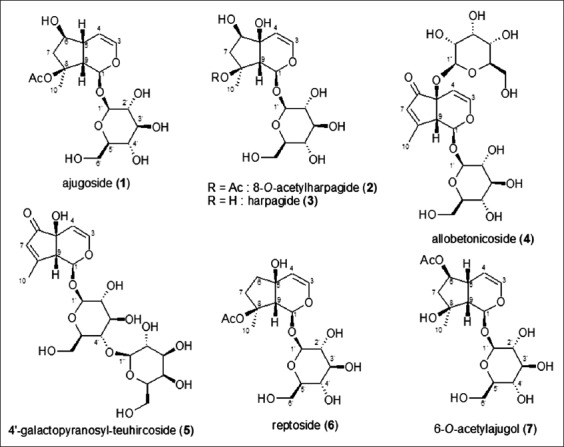
Iridoids from Alopecurus alopecuros subsp. divulsa
Figure 2.

Phenolics from Alopecurus alopecuros subsp. divulsa
DISCUSSION
Chemosystematic Implications of Isolated Compounds
The identified iridoids have all chemosystematic relevance. In particular, 2 and 3 are considered family markers, 4 is characteristic of the section Betonica, and 5 has never been reported in other Stachys species so that it may be regarded as a chemotaxonomic marker at a subspecific level. Reptoside (6) resulted to be a rare metabolite in the Stachys genus because its occurrence has been reported only in a few species, namely Betonica officinalis (syn. of Stachys officinalis) [23] and S. macrantha [24]. 6-O-acetyl-ajugol (7), is also a rare metabolite in the Lamiaceae family since it has been found only in Leonurus persicus so far [18]. It is also worth of mention the presence of ajugoside (1) and reptoside (6) which are iridoids widely distributed in the species of the Ajugoideae subfamily. In fact, 1 was mainly reported in the Ajuga genus (e.g. Ajuga tenorei and Ajuga chamaepitys) [25,26], although its presence was also signaled in a few Lamioideae species as Melittis melissophyllum subsp. melissophyllum [19] and species of the genera Stachys and Sideritis. The occurrence of 1 in the Stachys genus is limited to a few species such as B. officinalis (syn. of S. officinalis (L.) Trevis.) [2], S. macrantha [24], S. alpina [2], Stachys germanica [2,27] and Stachys recta [2], and it has been identified also in the taxonomically related Sideritis genus like for instance in Sideritis romana [28], and Sideritis perfoliata subsp. perfoliata [29].
Considering their occurrence, compounds (1) and (6) may represent chemosystematic traits of proximity between Lamioideae and Ajugoideae subfamilies. The identification of 1 has been carried out by extensive NMR analysis on both mono - [Figures 3 and 4] and bidimensional [Figures 5 and 6] experiments since the assignment of resonances was not immediate for several signals, in particular for protons in 5, 6 and 9 positions on the iridoid skeleton as well as for protons in 3¢ and 5¢ positions of the glucose moiety [Figures 3 and 4].
Figure 3.
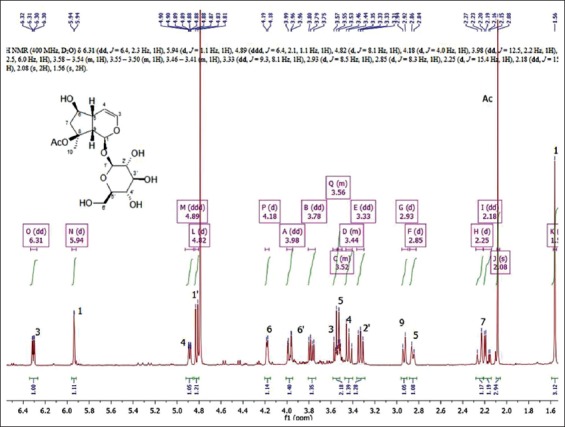
1H-NMR spectrum of ajugoside (1)
Figure 4.
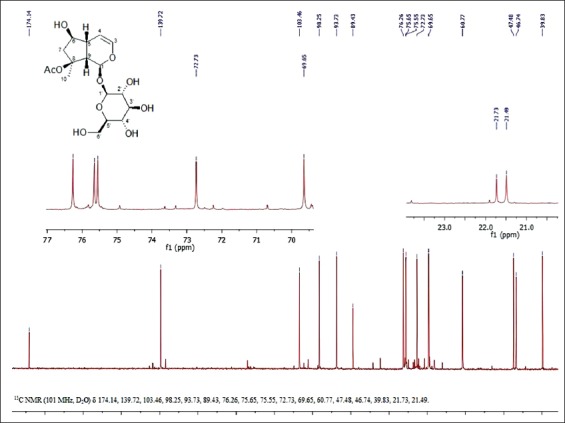
13C-NMR spectrum of ajugoside (1)
Figure 5.
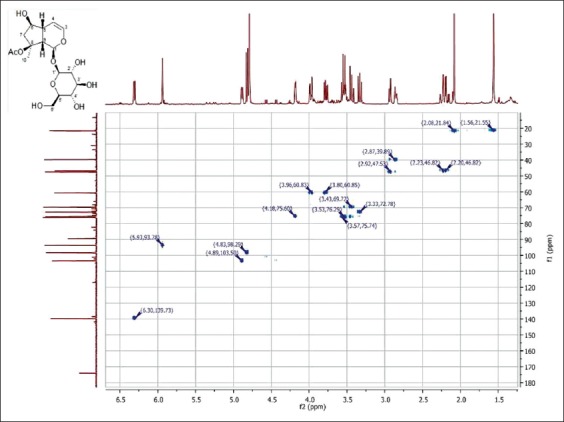
Heteronuclear single quantum correlation spectrum of ajugoside (1)
Figure 6.
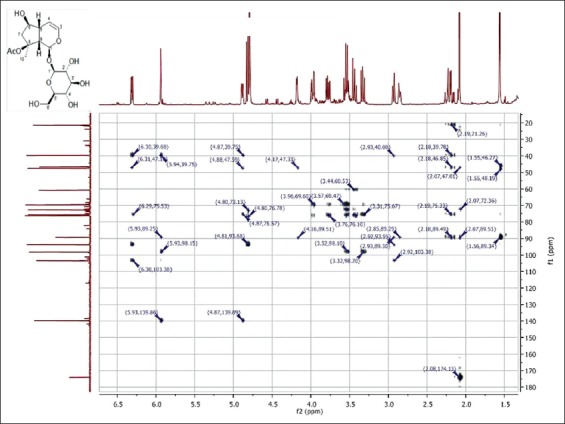
Heteronuclear multiple bond correlation spectrum of ajugoside (1)
In particular, the resonance of H-6 was readily visible in the proton spectrum at 4.18 ppm, but the corresponding carbon signal was very near to a glucose carbon resonance and has been assigned by the direct HSQC correlation [Figure 5] with the signal resonating at 75.55 ppm. On the contrary, the assignment of protons and carbons in the position 5 and 9 was not immediate, and several long range correlations resulted to be crucial for discriminating the resonances of these nuclei. The signals relative to the positions 5 and 9 present resonances in the proton spectrum at 2.93 and 2.85 ppm, both as broad signals, and the study of the coupling constants gave no help for the structure elucidation. In the HSQC spectrum, a direct correlation between the proton signal at 2.93 ppm and the carbon resonating at 47.48 ppm was recorded as well as the correlation between the proton at 2.85 and the carbon at 39.83 ppm. This permitted to assign the respective carbons signals. In the HMBC experiments, [Figure 6] the only diagnostic correlation which permitted to differentiate the positions 5 and 9 was a long range correlation between H-3 (6.31 ppm) and the carbon resonating at 39.83 ppm, which could be assigned to C-5 of the iridoid skeleton, since almost all the proton signals correlated with both the carbons at 39.83 and 47.48 ppm. In fact, H-3 is relatively far from C-9, and this kind of signal could not be visualized with the coupling constant of 8 Hz set in the experiment. Using the HMBC correlations, it was also possible to differentiate the positions 3¢ and 5¢ on the glucopyranose unit. In particular, the resonances of the positions 1¢, 2¢, 4¢, and 6¢ (98.25, 72.73, 69.65, and 60.77, respectively) were readily assignable to the saccharidic moiety, while the signals relative to 3¢ and 5¢ might be differentiated on the basis of their correlation with near nuclei [Figures 5 and 6].
More specifically, from HMBC experiments the following long-range correlations were recognized: Between the proton signal at 3.33 ppm (H-2¢) and the carbon at 75.65 (C-3¢); the proton at 3.34 ppm (H-4¢) with carbons at 76.26 (C-5¢) and 75.65 (C-3¢); the protons at 3.98-3.78 (H-6¢) with carbon resonating at 76.26 (C-5¢). The latter correlation is particularly crucial for the assignation of the C-5¢ position because H-6¢ cannot correlate with C-3¢. The complete assignments of resonances are reported in Table 1.
Chlorogenic acid (8) has been isolated for the first time from S. alopecuros subsp divulsa, although it has been already found in several Stachys species as S. tymphaea [8], S. lanata [30], S. officinalis [31], S. recta [32], S. byzantina, S. iberica subsp. iberica var. densipilosa [33], and S. glutinosa [34]. In most of these species, the chlorogenic acid (8) resulted to be the main polyphenolic component occurring in the polar fraction just like in this case [Figure 2].
Furthermore, b-arbutin (9) was a metabolite identified for the first time in this species. It proved to be a quite rare compound in the Stachys genus since its presence has been signaled only in S. germanica subsp. salviifolia [7]. The presence of verbascoside (10), a quite common phenyletanoid glycoside (PhGs) in Lamiaceae, has been confirmed, while stachysoside A (11), also known with the name lavandulifolioside, resulted to be as a new constituent of S. alopecuros subsp. divulsa. PhGs are compounds with a chemosystematic relevance in Asterids since their cooccurrence with iridoid glycosides, as in the studied case, has been largely confirmed [35]. The presence of 11 was noteworthy since it is not an ubiquitous compound, especially in the Stachys genus where it has been recognized only in a few species such as S. lavandulifolia [36], S. sieboldii [15], and S. tymphaea [8]. This compound resulted to be a constituent of other systematically related genera such as Leonurus [37,38], Lagochilus [39], and Sideritis [40].
Bioactivities of Isolated Compounds
The isolated compounds are responsible for several interesting activities. In particular, iridoids are known to possess anti-inflammatory properties. Harpagide (3) and its derivatives are constituents of Harpagophytum procumbens D.C. (Pedaliaceae), a medicinal plant native to Namibia and commonly known as Devil’s Claw. This plant has been widely studied for its anti-inflammatory and analgesic effects which were demonstrated also in in vivo models, principally in rats [41-43]. The target of harpagide and its derivatives is represented by the inhibition of COX-2, an enzyme deputed to the production of the proinflammatory mediators prostaglandins and leukotrienes. Recent docking studies have demonstrated that harpagide is a selective inhibitor of COX-2, binding its active site with a strong interaction and being stabilized by 10 hydrogen bonds [44]. This confirms, on a molecular base, the observed anti-inflammatory and analgesic actions exerted by plants containing harpagide derivatives. Beside the anti-inflammatory action, harpagide (3) results a modulator of Tumor necrosis factor a (TNF-a) secretion and induces the expression of several proteins involved in cell migrations. It shows an immunomodulatory effect facilitating the leukocyte migration in the inflamed tissues [45]. The latter is a very important role because the inflammatory process is not only responsible of pain and loss of function but it is also involved in the onset and progression of degenerative diseases, including cardiovascular disorders and cancer. In a similar way, 8-O-acetyl harpagide (3) also showed a dose-related inhibition of leukocyte adhesion and transmigration in a system based on human umbilical vein endothelial cells, and human monocytic leukemia cell line THP-1 previously activated with TNF-a [46].
It was also studied, the protective effect of harpagide (3) against bone loss in ovariectomized mouse model. It resulted that this iridoid stimulates the differentiation and maturation processes of osteoblasts and this conducted to an overall improved bone properties with the recovery of mineral density. The reduced levels of biochemical markers of bone loss in the serum of treated mice (alkaline phosphatase, osteocalcin, and C-terminal telopeptide) seems to be the major mode of action of harpagide (3) [47], thus demonstrating the potential role of this iridoid also in the prevention and treatment of age-dependent bone osteoporosis diseases.
From recent studies on iridoid activities, 8-O-acetylharpagide (2) and ajugoside (1) resulted to be useful compounds in the treatment of diabetes mellitus since they were able to stimulate the cellular glucose intake and lower the glucose blood level [38]. Another target of iridoids for the antidiabetic activity is represented by the inhibitory action, verified by docking studies, on glycogen phosphorylase-a [48]. In fact, several plant species rich in iridoids have been largely used in traditional medicine for the treatment of diabetes, e.g., Scrophularia deserti Del. [49] and Leonurus sibiricus L. [38].
The phenolic fraction of S. alopecuros subsp. divulsa was mainly composed by chlorogenic acid (8), which is also endowed with interesting activities [34]. This caffeoylquinic acid is a strong antioxidant [50], a good wound healer if topically applied on excisions [51] and has also antiviral action toward hepatitis B virus [52]. Furthermore, it shows antiproliferative action [34], inhibits carcinogenesis, strongly reduces the risk of cardiovascular diseases and significantly improves the metabolism of glucose. The latter is the main reason why it has recently drawn the attention from nutritionists for its high antidiabetic and anti-obesity properties [53]. The antioxidant and enzyme inhibitory activities in respect to acetylcholineserase, butrylcholinesterase, and a-amylase [33] may have a protective role in neurologic diseases such as Alzheimer’s disease, and metabolic disorders as diabetes mellitus.
The other phenolic constituents also have interesting biological activities. In fact, b-arbutin (9) possesses a strong antibacterial activity and is traditionally used for urinary tract infections [54]. It is also a tyrosinase inhibitor and is employed as a skin whitener because it inhibits the melanin synthesis [55].
The phenylethanoid glycoside verbascoside (10) shows an antibacterial action especially toward S. aureus [56] and anti-inflammatory activity [57]. More recently, in an in vivo study, it resulted to be an inhibitor of xanthine oxidase which reduced uric acid concentration in rat serum. These results may suggest its potential use to treat hyperuricemy [58].
For what concerns the activity of stachysoside A (11), in literature there are mainly studies conducted on extracts obtained from species containing this compound. In this context, it is noteworthy the neuroprotective effects observed in S. sieboldii tuber extract which resulted to improve the memory dysfunction associated with vascular dementia or Alzheimer’s disease in induced-ischaemia in mice [59]. The presence of antioxidant components resulted to have a primary role in neuroprotection and PhGs are well-known antioxidants. Species belonging to Leonurus genus, all containing (11) together with iridoids, have been largely used in the traditional Mongolian medicine for the treatment of diabetes mellitus [38] and in the treatment of neurological disorders such as anxiety, depression, and nervousness [37].
CONCLUSIONS
This phytochemical study on the endemic S. alopecuros subsp. divulsa shed light on three additional iridoid glucosides together with chlorogenic acid (8), b-arbutin (9), verbascoside (10), and stachysoside A (11) in the phenolic fraction. The presence of verbascoside has been already reported, while the other phenolics were identified for the first time in the studied species. The monoterpene glycoside pattern owned by S. alopecuros subsp. divulsa has been disclosed with respect to literature data, showing the presence of ajugoside (1), reptoside (6), and 6-O-acetyl-ajugol (7). All these compounds have chemosystematic relevance. In particular, 1 and 6 may represent a metabolic connection between Lamioideae and Ajugoideae subfamilies while 7 is a quite uncommon compound in the Lamiaceae family since it has been found only in L. persicus so far. We also took advantage of this occasion to report a complete NMR assignment for compound 1. From a therapeutic perspective, the isolated compounds are known for their antioxidant, antiproliferative, anti-inflammatory, analgesic, immunomodulatory, neuroprotective, and antidiabetic actions. Their occurrence in the studied species provides evidence of a possible natural source of bioactive compounds for extractive purposes but also of its potential as a natural remedy of medical importance.
Footnotes
Source of Support: Nil
Conflict of Interest: None declared.
REFERENCES
- 1.Govaerts R. World Checklist of Stachys L. Facilitated by the Royal Botanic Gardens, Kew 2012. Published on the Internet. Available from: http://apps.kew.org/wcsp/namedetail.do?name_id=194757 .
- 2.Háznagy-Radnai E, Balogh Á, Czigle S, Máthé I, Hohmann J, Blazsó G. Antiinflammatory activities of Hungarian Stachys species and their iridoids. Phytother Res. 2012;26:505–9. doi: 10.1002/ptr.3582. [DOI] [PubMed] [Google Scholar]
- 3.Hartwell JL. Plants Used Against Cancer: A Survey. Massachusetts: Quarterman Publications Inc; 1982. [Google Scholar]
- 4.Goren AC, Piozzi F, Akçiçek E, Kiliç T, Çarikçi S. Essential oil composition of twenty-two Stachys species (mountain tea) and their biological activities. Phytochem Lett. 2011;4:448–53. [Google Scholar]
- 5.Lewis WH, Elvin-Lewis MP. Medical Botany: Plants Affecting Man's Health. New York: Wiley; 1977. [Google Scholar]
- 6.Venditti A, Bianco A, Nicoletti M, Quassinti L, Bramucci M, Lupidi G, et al. Phytochemical analysis, biological evaluation and micromorphological study of Stachys alopecuros (L.). Benth. subsp divulsa (Ten.) Grande endemic to central Apennines, Italy. Fitoterapia. 2013;90:94–103. doi: 10.1016/j.fitote.2013.06.015. [DOI] [PubMed] [Google Scholar]
- 7.Venditti A, Serrilli AM, Di Cecco M, Ciaschetti G, Andrisano T, Bianco A. Phytochemical composition of polar fraction of Stachys germanica L. subsp salviifolia (Ten.) Gams, a typical plant of Majella National Park. Nat Prod Res. 2013;27:190–3. doi: 10.1080/14786419.2012.661732. [DOI] [PubMed] [Google Scholar]
- 8.Venditti A, Bianco A, Nicoletti M, Quassinti L, Bramucci M, Lupidi G, et al. Characterization of secondary metabolites, biological activity and glandular trichomes of Stachys tymphaea Hausskn from the Monti Sibillini National Park (Central Apennines, Italy) Chem Biodivers. 2014;11:245–61. doi: 10.1002/cbdv.201300253. [DOI] [PubMed] [Google Scholar]
- 9.Venditti A, Bianco A, Quassinti L, Bramucci M, Lupidi G, Damiano S, et al. Phytochemical analysis, biological activity, and secretory structures of Stachys annua (L.). L. subsp annua (Lamiaceae) from Central Italy. Chem Biodivers. 2015;12:1172–83. doi: 10.1002/cbdv.201400275. [DOI] [PubMed] [Google Scholar]
- 10.Piozzi F, Bruno M. Diterpenoids in the essential oils from the genus Stachys. Rec Nat Prod. 2009;3:120–5. [Google Scholar]
- 11.Conti F, Abbate G, Alessandrini A, Blasi C. An Annotated Checklist of the Italian Vascular Flora. Rome: Palombi Press; 2005. [Google Scholar]
- 12.Pignatti S. Flora d'Italia. Bologna: Edagricole; 1982. [Google Scholar]
- 13.Ballero M, Bianco A, Serrilli AM. Italian Patent, MI2009A000720. 2009 [Google Scholar]
- 14.Scarpati ML, Delle Monache F. Isolation from Verbascum sinuatum of two new glucosides, verbascoside and isoverbascoside. Ann Chim Rome. 1963;53:356–67. [Google Scholar]
- 15.Nishimura H, Sasaki H, Inagaki N, Chin M, Mitsuhashi H. Nine phenethyl alcohol glycosides from Stachys sieboldii. Phytochemistry. 1991;30:965–9. doi: 10.1016/0031-9422(91)85288-b. [DOI] [PubMed] [Google Scholar]
- 16.Thies H, Sulc D. Arbutus unedo L. I. Determination of arbutin in the leaves of the strawberry tree. Pharmazie. 1950;5:553–5. [PubMed] [Google Scholar]
- 17.Guiso M, Marini-Bettolo R, Agostini A. Ajugoside and ajugol: Structure and configuration. Gazz Chim Ital. 1974;104:25–33. [Google Scholar]
- 18.Tasdemir D, Scapozza L, Zerbe O, Linden A, Calis I, Sticher O. Iridoid glycosides of Leonurus persicus. J Nat Prod. 1999;62:811–6. doi: 10.1021/np980376e. [DOI] [PubMed] [Google Scholar]
- 19.Venditti A, Frezza C, Guarcini L, Maggi F, Bianco A, Serafini M. Reassessment of Melittis melissophyllum L. subsp melissophyllum iridoidic fraction. Nat Prod Res. 2016;30:218–22. doi: 10.1080/14786419.2015.1040792. [DOI] [PubMed] [Google Scholar]
- 20.Scarpati ML, Guiso M, Panizzi L. Harpagide acetate from Melittis melissophyllum. Tetrahedron Lett. 1965;6:3439–43. [Google Scholar]
- 21.Caprioli G, Alunno A, Beghelli D, Bianco A, Bramucci M, Frezza C, et al. Polar constituents and biological activity of the berry-like fruits from Hypericum androsaemum L. Front Plant Sci. 2016;7:232. doi: 10.3389/fpls.2016.00232. [DOI] [PMC free article] [PubMed] [Google Scholar]
- 22.Bobbitt JM, Segerbarth KP. In: Cyclopentanoid Terpene Derivatives. Ch. 1. Taylor WI, Battersby R, editors. New York, NY: Marcel Dekker Inc; 1969. [Google Scholar]
- 23.Jeker M, Sticher O, Çaliş İ, Rüedi P. Allobetonicoside and 6-O-acetylmioporoside: Two new iridoid glycosides from Betonica officinalis L. Helv Chim Acta. 1989;72:1787–91. [Google Scholar]
- 24.Çalis I, Başaran AA, Saracoǧlu I, Stcher O. Iridoid and phenylpropanoid glycosides from Stachys macrantha. Phytochemistry. 1991;31:167–9. doi: 10.1016/s0031-9422(00)98255-4. [DOI] [PubMed] [Google Scholar]
- 25.Frezza C, Venditti A, Di Cecco M, Ciaschetti G, Serafini M, Bianco A. Iridoids and phenylethanoid glycosides from the aerial parts of Ajuga tenorei an endemic Italian species. Nat Prod Res. 2017;31:218–23. doi: 10.1080/14786419.2016.1218490. [DOI] [PubMed] [Google Scholar]
- 26.Venditti A, Frezza C, Maggi F, Lupidi G, Bramucci M, Quassinti L, et al. Phytochemistry, micromorphology and bioactivities of Ajuga chamaepitys (L.) Schreb. (Lamiaceae Ajugoideae): Two new harpagide derivatives and an unusual iridoid glycosides pattern. Fitoterapia. 2016;113:35–43. doi: 10.1016/j.fitote.2016.06.016. [DOI] [PubMed] [Google Scholar]
- 27.Haznagy-Radnai E, Czigle S, Janicsak G, Mathe I. Iridoids of Stachys species growing in Hungary. J. Planar Chromatogr Mod TLC. 2006;19:187–90. [Google Scholar]
- 28.Venditti A, Frezza C, Guarcini L, Foddai S, Serafini M, Bianco A. Phytochemical study of a species with ethnopharmacological interest Sideritis romana L. Eur J Med Plants. 2016;12:1–9. [Google Scholar]
- 29.Charami MT, Lazari D, Karioti A, Skaltsa H, Hadjipavlou-Litina D, Souleles C. Antioxidant and antiinflammatory activities of Sideritis perfoliata subsp perfoliata (Lamiaceae) Phytother Res. 2008;22:450–4. doi: 10.1002/ptr.2333. [DOI] [PubMed] [Google Scholar]
- 30.Murata T, Endo Y, Miyase T, Yoshizaki F. Iridoid glycoside constituents of Stachys lanata. J Nat Prod. 2008;71:1768–70. doi: 10.1021/np8001805. [DOI] [PubMed] [Google Scholar]
- 31.Šliumpaite I, Venskutonis PR, Murkovic M, Ragažinskiene O. Antioxidant properties and phenolic composition of wood betony (Betonica officinalis L., syn Stachys officinalis L.) Ind Crops Prod. 2013;50:715–22. [Google Scholar]
- 32.Karioti A, Bolognesi L, Vincieri FF, Bilia AR. Analysis of the constituents of aqueous preparations of Stachys recta by HPLC-DAD and HPLC-ESI-MS. J Pharm Biomed Anal. 2010;53:15–23. doi: 10.1016/j.jpba.2010.03.002. [DOI] [PubMed] [Google Scholar]
- 33.Sarikurkcu C, Kocak MS, Uren MC, Calapoglu M, Tepe AS. Potential sources for the management global health problems and oxidative stress Stachys byzantina and S. iberica subsp. iberica var densipilosa. Eur J Integr Med. 2016;8:631–7. [Google Scholar]
- 34.Leporini L, Menghini L, Foddai M, Petretto GL, Chessa M, Tirillini B, et al. Antioxidant and antiproliferative activity of Stachys glutinosa L. Ethanol extract. Nat Prod Res. 2015;29:899–907. doi: 10.1080/14786419.2014.955490. [DOI] [PubMed] [Google Scholar]
- 35.Jensen SR. Systematic implications of the distribution of iridoids and other chemical compounds in the Loganiaceae and other families of the Asteridae. Ann Mo Bot Gard. 1992;79:284–302. [Google Scholar]
- 36.Başaran AA, Çalis I, Anklin C, Nishibe S, Sticher O. Lavandulifolioside: A new phenylpropanoid glycoside from Stachys lavandulifolia. Helv Chim Acta. 1988;71:1483–90. [Google Scholar]
- 37.Rauwald HW, Savtschenko A, Merten A, Rusch C, Appel K, Kuchta K. GABAA receptor binding assays of standardized Leonurus cardiaca and Leonurus japonicus extracts as well as their isolated constituents. Planta Med. 2015;81:1103–10. doi: 10.1055/s-0035-1546234. [DOI] [PubMed] [Google Scholar]
- 38.Pitschmann A, Zehl M, Heiss E, Purevsuren S, Urban E, Dirsch VM, et al. Quantitation of phenylpropanoids and iridoids in insulin-sensitising extracts of Leonurus sibiricus L. (Lamiaceae) Phytochem Anal. 2016;27:23–31. doi: 10.1002/pca.2583. [DOI] [PubMed] [Google Scholar]
- 39.Zhang CG, Lu Y, Wang ZT, Chou GX, Xu H. Chemical constituents from whole herb of Lagochilus platyacanthus. Chin Tradit Herb Drugs. 2014;45:3224–9. [Google Scholar]
- 40.Stanoeva JP, Stefova M, Stefkov G, Kulevanova S, Alipieva K, Bankova V, et al. Chemotaxonomic contribution to the Sideritis species dilemma on the Balkans. Biochem Syst Ecol. 2015;61:477–87. [Google Scholar]
- 41.Andersen ML, Santos EH, Seabra Mde L, da Silva AA, Tufik S. Evaluation of acute and chronic treatments with Harpagophytum procumbens on Freund's adjuvant-induced arthritis in rats. J Ethnopharmacol. 2004;91:325–30. doi: 10.1016/j.jep.2004.01.003. [DOI] [PubMed] [Google Scholar]
- 42.Lim DW, Kim JG, Han D, Kim YT. Analgesic effect of Harpagophytum procumbens on postoperative and neuropathic pain in rats. Molecules. 2014;19:1060–8. doi: 10.3390/molecules19011060. [DOI] [PMC free article] [PubMed] [Google Scholar]
- 43.Parenti C, Aricò G, Pennisi M, Venditti A, Scoto GM. Harpagophytum procumbens extract potentiates morphine antinociception in neuropathic rats. Nat Prod Res. 2016;30:1248–55. doi: 10.1080/14786419.2015.1052069. [DOI] [PubMed] [Google Scholar]
- 44.Rahimi A, Razmkhah K, Mehrnia M, Mohamadnia A, Sahebjamee H, Salehi S, et al. Molecular docking and binding study of harpagoside and harpagide as novel anti-inflammatory and anti-analgesic compound from Harpagophytum procumbens based on their interactions with COX-2 enzyme. Asian Pac J Trop Dis. 2016;6:227–31. [Google Scholar]
- 45.Schopohl P, Grüneberg P, Melzig MF. The influence of harpagoside and harpagide on TNFa-secretion and cell adhesion molecule mRNA-expression in IFNg/LPS-stimulated THP-1 cells. Fitoterapia. 2016;110:157–65. doi: 10.1016/j.fitote.2016.03.005. [DOI] [PubMed] [Google Scholar]
- 46.You Y, Wang J, Tong Y, Hao Q, Li Y, Yang H, et al. Anti-inflammatory effect of acetylharpagide demonstrated by its influence on leukocyte adhesion and transmigration in endothelial cells under controlled shear stress. Clin Hemorheol Microcirc. 2014;56:205–17. doi: 10.3233/CH-131704. [DOI] [PubMed] [Google Scholar]
- 47.Chung HJ, Kyung Kim W, Joo Park H, Cho L, Kim MR, Kim MJ, et al. Anti-osteoporotic activity of harpagide by regulation of bone formation in osteoblast cell culture and ovariectomy-induced bone loss mouse models. J Ethnopharmacol. 2016;179:66–75. doi: 10.1016/j.jep.2015.12.025. [DOI] [PubMed] [Google Scholar]
- 48.Vaidya HB, Ahmed AA, Goyal RK, Cheema SK. Glycogen phosphorylase-a is a common target for anti-diabetic effect of iridoid and secoiridoid glycosides. J Pharm Pharm Sci. 2013;16:530–40. doi: 10.18433/j3fs4f. [DOI] [PubMed] [Google Scholar]
- 49.Perry LM, Metzger J. Medicinal Plants of Southeast Asia. Cambridge, MA and London, UK: MIT Press; 1980. [Google Scholar]
- 50.Ohnishi M, Morishita H, Iwahashi H, Toda S, Shirataki YM, et al. Inhibitory effects of chlorogenic acids on linoleic acid peroxidation and haemolysis. Phytochemistry. 1994;36:579–83. [Google Scholar]
- 51.Chen WC, Liou SS, Tzeng TF, Lee SL, Liu IM. Effect of topical application of chlorogenic acid on excision wound healing in rats. Planta Med. 2013;79:616–21. doi: 10.1055/s-0032-1328364. [DOI] [PubMed] [Google Scholar]
- 52.Wang GF, Shi LP, Ren YD, Liu QF, Liu HF, Zhang RJ, et al. Anti-hepatitis B virus activity of chlorogenic acid, quinic acid and caffeic acid in vivo and in vitro. Antiviral Res. 2009;83:186–90. doi: 10.1016/j.antiviral.2009.05.002. [DOI] [PubMed] [Google Scholar]
- 53.Cho AS, Jeon SM, Kim MJ, Yeo J, Seo KI, Choi MS, et al. Chlorogenic acid exhibits anti-obesity property and improves lipid metabolism in high-fat diet-induced-obese mice. Food Chem Toxicol. 2010;48:937–43. doi: 10.1016/j.fct.2010.01.003. [DOI] [PubMed] [Google Scholar]
- 54.Yarnell E. Botanical medicines for the urinary tract. World J Urol. 2002;20:285–93. doi: 10.1007/s00345-002-0293-0. [DOI] [PubMed] [Google Scholar]
- 55.Sugimoto K, Nishimura T, Moser H. Inhibitory effects of several types of hydroquinone glycosides on human tyrosinase and melanogenesis inhibition of alpha-arbutin. Fragr J. 2005;33:60–6. [Google Scholar]
- 56.Avila JG, de Liverant JG, Martínez A, Martínez G, Muñoz JL, Arciniegas A, et al. Mode of action of Buddleja cordata verbascoside against Staphylococcus aureus. J Ethnopharmacol. 1999;66:75–8. doi: 10.1016/s0378-8741(98)00203-7. [DOI] [PubMed] [Google Scholar]
- 57.Speranza L, Franceschelli S, Pesce M, Reale M, Menghini L, Vinciguerra I, et al. Antiinflammatory effects in THP-1 cells treated with verbascoside. Phytother Res. 2010;24:1398–404. doi: 10.1002/ptr.3173. [DOI] [PubMed] [Google Scholar]
- 58.Wan Y, Zou B, Zeng H, Zhang L, Chen M, Fu G. Inhibitory effect of verbascoside on xanthine oxidase activity. Int J Biol Macromol. 2016;93:609–14. doi: 10.1016/j.ijbiomac.2016.09.022. [DOI] [PubMed] [Google Scholar]
- 59.Harada S, Tsujita T, Ono A, Miyagi K, Mori T, Tokuyama S. Stachys sieboldii (Labiatae Chorogi) protects against learning and memory dysfunction associated with ischemic brain injury. J Nutr Sci Vitaminol (Tokyo) 2015;61:167–74. doi: 10.3177/jnsv.61.167. [DOI] [PubMed] [Google Scholar]


